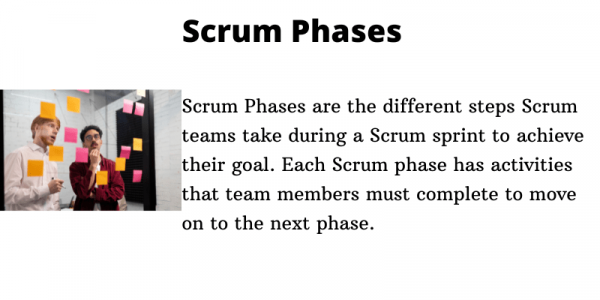There are many misconceptions about the Scrum Framework. Some people think there are only three Scrum phases- initiation, development, and deployment. Others believe that Scrum is all about chaos and disorder.
There are five phases in Scrum, and each phase is critical to the project’s success. Read on to learn more about Scrum and the different stages.
What is Scrum in Agile?
Scrum is an Agile methodology for managing complex projects. In Scrum, all aspects of the project are broken down into small, manageable pieces called sprints. Sprints are typically two weeks long; each builds upon the previous sprint until the project is complete.
One of the benefits of Scrum is that it helps to ensure that all stakeholders are on the same page and that everyone knows what they need to do and when it needs to be done.

What is a Scrum Phase?
Scrum Phases are the different steps Scrum teams take during a Scrum sprint to achieve their goal. Each Scrum phase has activities that team members must complete to move on to the next phase.
Scrum Phases are an essential part of the Scrum process, and each must be given the proper attention for teams to succeed.

Benefits of Using Scrum Phases for Project Management
Seasoned project managers agree that scrum phases offer several benefits. And as one progresses in their project management journey, harnessing the importance of these phases not only improves efficiency and overall process output but also allows for growth in individuals looking to improve their team and project management skills constantly.
Better prioritization
The Scrum backlog approach makes it simple for you to assign varying priorities to various aspects of a project. It allows you better to concentrate your resources on the essential components, ensuring that teams meet all necessary milestones as planned.
A sense of knowing
A Scrum framework provides organization and clarity to everyone working on a project by expectations and the plans for said project. There is usually a daily check-in so updates can be given and any questions that may have arisen.
Ideal communication
The Scrum phase also fosters communication within the team and with peers. It may make it simple for team members to get assistance to do their tasks more effectively and stay on schedule and budget.
Openness to adjustments
The Scrum phase is designed so that you can rapidly adapt when necessary. It means scrutinizing your work regularly and making corrections where needed, which will benefit the project.
Better KPI Monitoring
The Scrum phases framework includes processes for assessing performance throughout a Scrum project and the many sprints that makeup it. This structure can help you discover more accurate and valuable insights while reflecting on your work.

The 5 Scrum Phases
Scrum is typically used in software development, but you can apply it to any complex, innovative process. It promotes a flexible and collaborative approach to problem-solving. The Scrum methodology is based on five phases: initiation, planning and estimation, implementation, reviewing, and releasing.
Initiation Phase
The initial phase of Scrum is all about understanding the problem that needs to be solved. Also known as the outline planning phase, this phase includes identifying the Scrum Master, team members, and their roles and setting the Scrum goal.
The Scrum Master works with the product owner to help clarify the problem and ensure everyone is on the same page. Once the team is set, and the goal is clear, it’s time to move on to the next phase of Scrum: planning.
Importance of choosing a good scrum master and a scrum team
A good scrum master will deeply understand the scrum process and manage the team effectively. They will also be able to provide support and guidance when needed and be able to resolve any conflicts that may arise.
A good scrum team will be cohesive and satisfactorily understand their roles and responsibilities. They will work well together and be able to complete the project within the timelines set by the scrum master.
Choosing a good scrum master and a good scrum team is essential for the success of any project. By doing so, you can be confident that the project will be completed on time, within budget, and to the required standards.
Planning and Estimation Phase
The next Scrum phase is sprint planning and estimation. In this phase, the team creates a scrum process plan for how they will achieve the Scrum goal. They also estimate the amount of time and resources required.
This sprint planning session is crucial because it ensures that the Scrum team clearly understands what they need to do and how long it will take. Without this information, it would be difficult to track progress and make adjustments as necessary.
The result of the planning and estimation phase is a Sprint backlog, a prioritized list of tasks that need to be completed to achieve the Scrum goal.
Implementation Phase
The Scrum implementation phase is when the team starts working on solving the problem on the sprint backlog. They use the Scrum framework to guide their work and track their progress. It is the phase where Scrum shines, as it provides a flexible and iterative approach that helps teams rapidly solve complex problems.
Good communication and collaboration between team members are crucial to success in this phase. Each member must understand their role and be willing to work together toward completing the sprint backlog.
Reviewing Phase
The reviewing phase focuses on assessing whether or not the Scrum team has met the Scrum goal. The Scrum Master leads the sprint review meeting and establishes what documentation should be produced. The team then looks at their work and decides if they have completed all of the tasks necessary to meet the sprint backlog. If they have completed all of the functions, they move on to the next Scrum goal. If they have not completed all of the parts, they move on to the retrospective phase.
Releasing phase
Also called the project closure phase, it is the team evaluates what they have learned from the experience. After which, the group decides what to do with the product of their work. Scrum is an iterative process, so these phases may be repeated multiple times before reaching a final solution.
The release stage is vital because it ensures that the product meets the customer’s needs and is up to Scrum quality standards. It also allows the team to reflect on their work and learn from their experience. After the product is released, the team will continue to monitor its performance and make changes as needed.
How Come Some Sites Say There are Three Scrum Phases, But Some Say There are Five?
Other schools of thought simplify the 5 phases we previously talked about into three main steps—pre-game, game, and post-game. But in reality, this is just a condensed version of the five phases we discussed.
The main difference is that in the 3 phase model, the initiation and planning phases are combined into a single “pre-game” phase. Similarly, the reviewing and releasing phases are combined into a single “post-game” phase while the implementation phase remains unchanged.
The advantage of the 3 phase model is that it is simpler and easier to understand. However, it does not provide as much detail as the 5 phase model. As a result, it may be less helpful for teams new to Scrum or struggling with implementation.
There are various schools of thought regarding the Scrum phases, but generally, they all follow a similar pattern. The main difference is in the level of detail provided and how easy they are to understand.
The three-phase model is more straightforward than the five-phase model but may be less helpful for teams new to Scrum or struggling with implementation. As a result, it is crucial to choose a model that fits your needs and makes sense for your team.
Whichever model you choose, make sure that you take the time to understand each stage so that you can achieve success with Scrum.
What are the three main phases?
The three main phases are pre-game, game, and post-game. These phases correspond to the initiation, planning, implementation, and review and release phases.
How long does a scrum phase last?
Each phase lasts for a sprint, which is typically two weeks. However, you can adjust the sprint length depending on the team’s needs.
What is the difference between a sprint and a phase?
A sprint is a time-boxed period during which a Scrum Master and teamwork complete a set of tasks. A phase is a portion of the overall project lifecycle, while Sprints are part of phases. There can be multiple sprints within a single phase.
